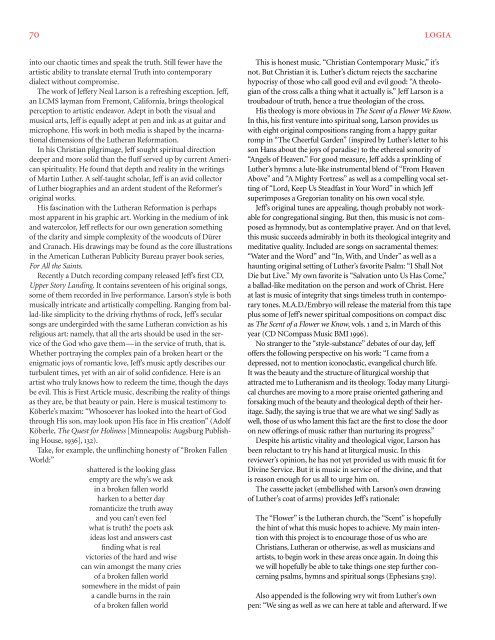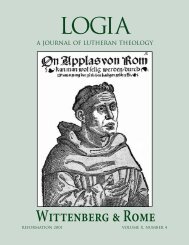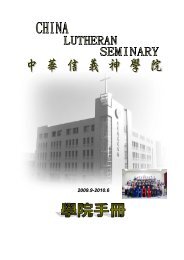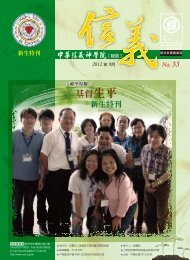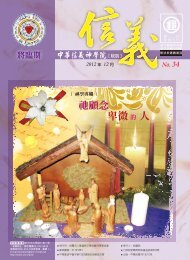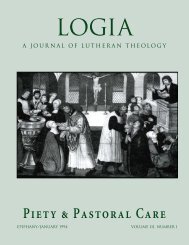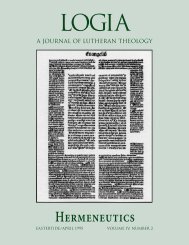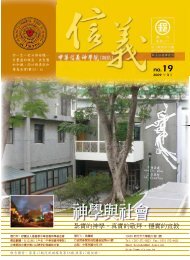05-4 Theology of the..
05-4 Theology of the..
05-4 Theology of the..
You also want an ePaper? Increase the reach of your titles
YUMPU automatically turns print PDFs into web optimized ePapers that Google loves.
70 LOGIA<br />
into our chaotic times and speak <strong>the</strong> truth. Still fewer have <strong>the</strong><br />
artistic ability to translate eternal Truth into contemporary<br />
dialect without compromise.<br />
The work <strong>of</strong> Jeffery Neal Larson is a refreshing exception. Jeff,<br />
an LCMS layman from Fremont, California, brings <strong>the</strong>ological<br />
perception to artistic endeavor. Adept in both <strong>the</strong> visual and<br />
musical arts, Jeff is equally adept at pen and ink as at guitar and<br />
microphone. His work in both media is shaped by <strong>the</strong> incarnational<br />
dimensions <strong>of</strong> <strong>the</strong> Lu<strong>the</strong>ran Reformation.<br />
In his Christian pilgrimage, Jeff sought spiritual direction<br />
deeper and more solid than <strong>the</strong> fluff served up by current American<br />
spirituality. He found that depth and reality in <strong>the</strong> writings<br />
<strong>of</strong> Martin Lu<strong>the</strong>r. A self-taught scholar, Jeff is an avid collector<br />
<strong>of</strong> Lu<strong>the</strong>r biographies and an ardent student <strong>of</strong> <strong>the</strong> Reformer’s<br />
original works.<br />
His fascination with <strong>the</strong> Lu<strong>the</strong>ran Reformation is perhaps<br />
most apparent in his graphic art. Working in <strong>the</strong> medium <strong>of</strong> ink<br />
and watercolor, Jeff reflects for our own generation something<br />
<strong>of</strong> <strong>the</strong> clarity and simple complexity <strong>of</strong> <strong>the</strong> woodcuts <strong>of</strong> Dürer<br />
and Cranach. His drawings may be found as <strong>the</strong> core illustrations<br />
in <strong>the</strong> American Lu<strong>the</strong>ran Publicity Bureau prayer book series,<br />
For All <strong>the</strong> Saints.<br />
Recently a Dutch recording company released Jeff’s first CD,<br />
Upper Story Landing. It contains seventeen <strong>of</strong> his original songs,<br />
some <strong>of</strong> <strong>the</strong>m recorded in live performance. Larson’s style is both<br />
musically intricate and artistically compelling. Ranging from ballad-like<br />
simplicity to <strong>the</strong> driving rhythms <strong>of</strong> rock, Jeff’s secular<br />
songs are undergirded with <strong>the</strong> same Lu<strong>the</strong>ran conviction as his<br />
religious art: namely, that all <strong>the</strong> arts should be used in <strong>the</strong> service<br />
<strong>of</strong> <strong>the</strong> God who gave <strong>the</strong>m—in <strong>the</strong> service <strong>of</strong> truth, that is.<br />
Whe<strong>the</strong>r portraying <strong>the</strong> complex pain <strong>of</strong> a broken heart or <strong>the</strong><br />
enigmatic joys <strong>of</strong> romantic love, Jeff’s music aptly describes our<br />
turbulent times, yet with an air <strong>of</strong> solid confidence. Here is an<br />
artist who truly knows how to redeem <strong>the</strong> time, though <strong>the</strong> days<br />
be evil. This is First Article music, describing <strong>the</strong> reality <strong>of</strong> things<br />
as <strong>the</strong>y are, be that beauty or pain. Here is musical testimony to<br />
Köberle’s maxim: “Whosoever has looked into <strong>the</strong> heart <strong>of</strong> God<br />
through His son, may look upon His face in His creation” (Adolf<br />
Köberle, The Quest for Holiness [Minneapolis: Augsburg Publishing<br />
House, 1936], 132).<br />
Take, for example, <strong>the</strong> unflinching honesty <strong>of</strong> “Broken Fallen<br />
World:”<br />
shattered is <strong>the</strong> looking glass<br />
empty are <strong>the</strong> why’s we ask<br />
in a broken fallen world<br />
harken to a better day<br />
romanticize <strong>the</strong> truth away<br />
and you can’t even feel<br />
what is truth <strong>the</strong> poets ask<br />
ideas lost and answers cast<br />
finding what is real<br />
victories <strong>of</strong> <strong>the</strong> hard and wise<br />
can win amongst <strong>the</strong> many cries<br />
<strong>of</strong> a broken fallen world<br />
somewhere in <strong>the</strong> midst <strong>of</strong> pain<br />
a candle burns in <strong>the</strong> rain<br />
<strong>of</strong> a broken fallen world<br />
This is honest music. “Christian Contemporary Music,” it’s<br />
not. But Christian it is. Lu<strong>the</strong>r’s dictum rejects <strong>the</strong> saccharine<br />
hypocrisy <strong>of</strong> those who call good evil and evil good: “A <strong>the</strong>ologian<br />
<strong>of</strong> <strong>the</strong> cross calls a thing what it actually is.” Jeff Larson is a<br />
troubadour <strong>of</strong> truth, hence a true <strong>the</strong>ologian <strong>of</strong> <strong>the</strong> cross.<br />
His <strong>the</strong>ology is more obvious in The Scent <strong>of</strong> a Flower We Know.<br />
In this, his first venture into spiritual song, Larson provides us<br />
with eight original compositions ranging from a happy guitar<br />
romp in “The Cheerful Garden” (inspired by Lu<strong>the</strong>r’s letter to his<br />
son Hans about <strong>the</strong> joys <strong>of</strong> paradise) to <strong>the</strong> e<strong>the</strong>real sonority <strong>of</strong><br />
“Angels <strong>of</strong> Heaven.” For good measure, Jeff adds a sprinkling <strong>of</strong><br />
Lu<strong>the</strong>r’s hymns: a lute-like instrumental blend <strong>of</strong> “From Heaven<br />
Above” and “A Mighty Fortress” as well as a compelling vocal setting<br />
<strong>of</strong> “Lord, Keep Us Steadfast in Your Word” in which Jeff<br />
superimposes a Gregorian tonality on his own vocal style.<br />
Jeff’s original tunes are appealing, though probably not workable<br />
for congregational singing. But <strong>the</strong>n, this music is not composed<br />
as hymnody, but as contemplative prayer. And on that level,<br />
this music succeeds admirably in both its <strong>the</strong>ological integrity and<br />
meditative quality. Included are songs on sacramental <strong>the</strong>mes:<br />
“Water and <strong>the</strong> Word” and “In, With, and Under” as well as a<br />
haunting original setting <strong>of</strong> Lu<strong>the</strong>r’s favorite Psalm: “I Shall Not<br />
Die but Live.” My own favorite is “Salvation unto Us Has Come,”<br />
a ballad-like meditation on <strong>the</strong> person and work <strong>of</strong> Christ. Here<br />
at last is music <strong>of</strong> integrity that sings timeless truth in contemporary<br />
tones. M.A.D./Embryo will release <strong>the</strong> material from this tape<br />
plus some <strong>of</strong> Jeff’s newer spiritual compositions on compact disc<br />
as The Scent <strong>of</strong> a Flower we Know, vols. 1 and 2, in March <strong>of</strong> this<br />
year (CD NCompass Music BMI 1996).<br />
No stranger to <strong>the</strong> “style-substance” debates <strong>of</strong> our day, Jeff<br />
<strong>of</strong>fers <strong>the</strong> following perspective on his work: “I came from a<br />
depressed, not to mention iconoclastic, evangelical church life.<br />
It was <strong>the</strong> beauty and <strong>the</strong> structure <strong>of</strong> liturgical worship that<br />
attracted me to Lu<strong>the</strong>ranism and its <strong>the</strong>ology. Today many Liturgical<br />
churches are moving to a more praise oriented ga<strong>the</strong>ring and<br />
forsaking much <strong>of</strong> <strong>the</strong> beauty and <strong>the</strong>ological depth <strong>of</strong> <strong>the</strong>ir heritage.<br />
Sadly, <strong>the</strong> saying is true that we are what we sing! Sadly as<br />
well, those <strong>of</strong> us who lament this fact are <strong>the</strong> first to close <strong>the</strong> door<br />
on new <strong>of</strong>ferings <strong>of</strong> music ra<strong>the</strong>r than nurturing its progress.”<br />
Despite his artistic vitality and <strong>the</strong>ological vigor, Larson has<br />
been reluctant to try his hand at liturgical music. In this<br />
reviewer’s opinion, he has not yet provided us with music fit for<br />
Divine Service. But it is music in service <strong>of</strong> <strong>the</strong> divine, and that<br />
is reason enough for us all to urge him on.<br />
The cassette jacket (embellished with Larson’s own drawing<br />
<strong>of</strong> Lu<strong>the</strong>r’s coat <strong>of</strong> arms) provides Jeff’s rationale:<br />
The “Flower” is <strong>the</strong> Lu<strong>the</strong>ran church, <strong>the</strong> “Scent” is hopefully<br />
<strong>the</strong> hint <strong>of</strong> what this music hopes to achieve. My main intention<br />
with this project is to encourage those <strong>of</strong> us who are<br />
Christians, Lu<strong>the</strong>ran or o<strong>the</strong>rwise, as well as musicians and<br />
artists, to begin work in <strong>the</strong>se areas once again. In doing this<br />
we will hopefully be able to take things one step fur<strong>the</strong>r concerning<br />
psalms, hymns and spiritual songs (Ephesians 5:19).<br />
Also appended is <strong>the</strong> following wry wit from Lu<strong>the</strong>r’s own<br />
pen: “We sing as well as we can here at table and afterward. If we


